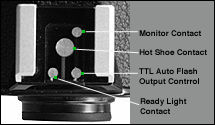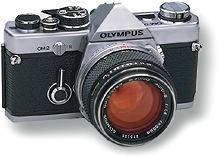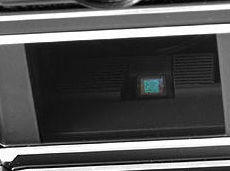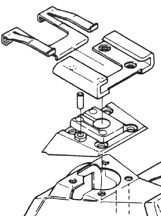Flash Photography
The Nikon FA has three ways to control flash in the TTL OTF
(Through-the-Lens Off the Film Plane) flash mode, automatic flash which
utilises the flash unit's light sensor to determines, or with manual flash
which require you to measure and set the the exposure with aperture and
shutter speed and lastly, a not so conventional in these days - Pneumatic bulb
or tube to trip the shutter also can be used. The Nikon FA synchronizes with
electronic flash at all shutter speeds of 1/250 second or slower, as well as
at M250 and B. For M, FP, and F-type flash bulbs, it will be synchronised at
shutter speeds of 1/30 second or slower, including the B
setting.
 There are two ways of physically mounting a flash on the FA. The convenience of having an standard ISO-type accessory shoe facilitates most common flash units to be used on the camera. Another way is to use the PC terminal in the front of the camera body for cable flash. |
In earlier sections, we have discussed the FA's various exposure control methods in the aperture priority AE, Programmed, shutter priority AE, manual mode and stopped down metering exposure measurement. The FA's original matrix metering principle has upgraded into flash photography in some of the AF camera. The FA, however, only has the matrix in the few AE modes and is NOT capable of matrix metering in the flash mode yet. |
When the light level is low and calls for the help of an artificial light source (Unless you are in long time exposure -B setting to capture 'natural' night scenes), most of the time you would need an artificial illumination from a flash.
The FA flash metering is a vast improvement as compared
with the FE but shared the technology employs in the FE2.The accessory shoe of
the FA allows direct mounting of some dedicated Nikon Speedlight like SB-15,
SB-16B, SB-18, SB-19 or other electronic flash with an ISO-type mounting foot.
Other flash units may be mounted with a flash unit coupler. The four
electrical contacts in the shoe provide the following: Proper synchronization
of the flash unit, automatic flash output stop, identification of a TTL flash
unit, and both ready-light indication in the camera's viewfinder (via and LED)
and auto-switching to the proper sync speed of 1/250sec.with Nikon dedicated
flash units.
While the most exciting feature within the flash mode
during that time was the FA's capability in TTL OTF flash metering.
What is TTL OTF flash metering
?
The TTL Off the Film plane flash metering
was pioneered by Olympus. The OM2n was the first SLR that used this technology
in 1975. It has three sensors, a pair near the eyepiece reading and provide
viewfinder information. But another blue photocell housed at the mirror box,
reading light continuously during an exposure until adequate amount of light
has been accumulated before it closes the curtain.
 |
This metering method can be handle for both ambience and flash. In 1980, Pentax came close to such design with their top of the line model, Pentax LX. Both are still considered the most 'sensitive' metering system, even measured by today's standard. |
As you have already know, the entire amount of power will be discharged in the manual flash mode (Depends on the 'power' of the flash, represented in guide number and you have to divide the guide number by the distance to find out the effective f number i.e.10' divided by a flash with guide number of 20 = f2.0. It is also affected by other variable flash technique eg. Bounce flash needs compensation as the 'power' has been 'diluted' etc, film speed also affects its working range eg, aperture f4 at ASA/ISO100 will be f5.6 when you change the film to ASA/ISO 200 or when the effective distance is double). Most electronic flash has a sensor built on the flash to sense the reflectance from the subject and regulate the amount of output. A electronic flash unit uses batteries to charge a capacitor and its output regulators will cut off the flash output as measured illumination is received and deemed sufficient for a proper flash exposure. Advantage is, it reduces battery drain and recycle time.
TTL flash metering is more superior than an ordinary electronic flash metering. The sensor is now located in the camera body, behind the lens you are using and it measures the amount of light that reflect off the actual film plane to regulate the amount of output from the flash for a proper flash exposure.
This technique, pioneered by Olympus in 1975 in their OM2n was a technically perfect solution for flash metering and exposure. However, it was enhanced further by Nikon in the F90x (F5 as well), as in most cases, the average TTL flash metering works like center weighted average metering, Nikon has manage successfully transferred their patented Matrix metering to the TTL Flash for, multi segments flash metering.
Unfortunately, this works only with flash that has dedicated functions in line with specific cameras that have been designed to take advantage of this technique (The very innovative Contax RTS III is the only camera that has TTL flash metering that works independently, regardless of origin).
Both Nikon FA and FE2 offer a TTL flash metering
capability. The design concept may not be as sophisticated as today's flash
metering in some of the top notch AF Nikon bodies, but it works independently
if you are to compare with the Nikon F3's flash metering (The F3 uses a
single SPD cells that housed at the bottom of the main reflex
mirror box to perform normal TTL and TTL flash
metering). The FA/FE2 has a pair of SPD cells to do ambience metering and
another separate SPD cell locatingunder the reflex mirror box, facing backward
to the film to perform TTL flash metering during flash exposure.
To
maximise the benefit of TTL OTF flash metering, you have to be very careful in
making selection when you invest into a flash for your FA. As some flash units
may offer only manual flash mode, some are capable of automatic flash mode
(Usually come with manual control), and others may function in the TTL mode as
well. Unfortunately, as with lens mount, most camera manufacturers designed
their flash without compatibility with other manufacturers even when they are
using the standard ISO-type accessory shoe. BUT all flashes can be used in
manual or even in many cases, automatic mode - except TTL or some specific
proprietary designs.
 |
The metering cell is a rectangular shaped to read the similarly sized film size. Based on heavily center weighted average metering methods. This works very well with many TTL flash that Nikon produced over the years. |
Others similar flash designed for cameras like F3 has to use a flash coupler - at the expense of TTL, so invest wisely into the right flash. (Actually, current dedicated AF flash from Nikon will function properly with an FE2/FA in the TTL mode as well, the trick is the terminals on the hot shoe - obviously, without the benefits of AF function). As explained earlier, the sensor only meter the light. The actual computation is done by the camera's CPU for these essential tasks and data crunching, regulating the right amount of light intensity, relaying cut off instructions and performing the normal automatic functions. It sounds easy, but the communication is quite complex and sophisticated. For instance, to reduce signal noise, two separate X-contacts lead wires from other lead wires and routing has been re-arrange to cross the circuit pattern to the SPD cells, this improve the reliabilty of the camera as well.
 |
That is no doubt that TTL flash can open up a lot of potential in flash photography. It will works in day and night. Since light is measured at through the lens and off the film plane, theoretically you should be getting a high rate of successful flash pictures than conventional auto or manual flash photography. Fill light in broad day light was made easier with the higher sync speed of 1/250 sec. While at a long time exposure, you can use or adjust the flash output to light up section of the scene. You can even work in multiple TTL flash with some dedicated off camera sync cords for different lighting effects. Or you can mix auto or manual flash with TTL with a few slave units (Needs calculations) while the main subject still in TTL mode. |